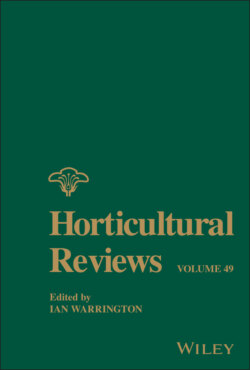Читать книгу Horticultural Reviews, Volume 49 - Группа авторов - Страница 18
V. MORPHOLOGY OF OAKLEAF HYDRANGEA
ОглавлениеThe phenotypic diversity in H. quercifolia is less than that of other Hydrangea species. In her 1957 monograph of the genus, McClintock notes that oakleaf hydrangea is “remarkably uniform throughout its range” and a review of the available cultivars confirms this phenomenon (discussed in further detail below) (McClintock 1957). There is little variation in the growth habit other than overall size; dwarf forms are available, but all display a broadly mounded habit. Variation exists in floral characteristics to an extent, mostly in size of panicle and sepals, but also in coloration and flowering time.
Hydrangea quercifolia has opposite leaves with 5 to 7 lobes and pinnate venation, resulting in a superficial resemblance to the leaves of lobed oak (Quercus) species. The margins are coarsely serrate, and both leaf surfaces are pubescent with the abaxial surface more so than the adaxial surface. Apical buds and young leaves often have very high trichome densities and are therefore highly pubescent. Interestingly, H. quercifolia is the only Hydrangea species to have branched trichomes with tannin deposits (Stern 1978). Fall leaf color is variable according to genotype and environmental conditions, such as shade, and ranges from pale yellow to burgundy red.
The stems are densely pubescent and coarse, developing exfoliating bark with age. The growth rings of H. quercifolia, like that of several other Hydrangea species, are semi‐porous; a distinguishing feature of H. quercifolia wood is the presence of axial xylem parenchyma (Stern 1978). Year‐old and older stems have abundant root initials or latent buds, which likely aid the plant in self‐propagation by layering.
In the wild, mature plants occasionally grow to greater than 5 m in height. Oakleaf hydrangea is often at least as wide as it is tall, and older plants tend to develop a spreading habit as the lower branches naturally propagate by layering. Wild plants tend to produce few to several clumps in close proximity to one another, spreading both by stem layering and by rhizomatic suckering (Figure 1.5). In the landscape, many cultivars can be 2 to 3 m in height, with dwarf cultivars reaching only 0.5 to 1 m at maturity.
Oakleaf hydrangea blooms from May through June in its native range, flowering on the previous season’s wood (Figure 1.6a). Inflorescences are panicles with fully fertile, perfect florets in the center that are partly covered by semi‐sterile florets with conspicuous petaloid sepals around the exterior (Figure 1.6b). Each fertile floret contains two stigmas and up to 10 stamens. Conspicuous florets indeed do possess all reproductive parts, albeit in reduced size. There are four orbicular conspicuous sepals which are typically white in color, fading to various shades of pink or brown as the inflorescence senesces. In a study of floral morphology in the tribe Hydrangeeae, Jacobs (2010) found H. quercifolia to have the highest number of conspicuous florets per inflorescence out of 36 taxa examined, with up to 50 per inflorescence. This is twice as many as the species with the next highest number, H. paniculata, having up to 25 conspicuous florets per inflorescence. In that study, H. quercifolia was found to be the only species to consistently produce more than 20 conspicuous florets per inflorescence. These data show the promising potential for H. quercifolia to serve as a striking landscape plant with large conspicuous inflorescences.
Figure 1.5 Photographs of Hydrangea quercifolia clonal habit. Each photograph displays the clumping nature of oakleaf hydrangea in the wild.
Figure 1.6 Stages of floral development: (a) young flower bud; (b) full flower;(c) senescing flower with developing fruit; (d) senesced flower with dehiscent fruit.
(Source: Photo credits: A. Sherwood.)
Hydrangea quercifolia fruit are dry dehiscent capsules, which fade from green during the growing season to brown at maturity when the seeds dehisce. Once pollinated, the conspicuous florets invert and the fruit begin to ripen (in Figure 1.6 compare the orientation of florets in 1.6b and 1.6c). The stigmas dry and form horn‐shaped appendages on the top of the capsule with an aperture between them to allow seed dispersal. Each fruit contains several seeds, which are relatively small, approximately 0.6 mm in length, with longitudinal striations (Figure 1.6d) (Hufford 1995). Seed color ranges from light tan to dark brown, being ellipsoidal to ovate in shape.
